Technologies
[5]Activities for Environmental Conservation
- Outline of JWA’s Environment Conservation Activities
- JWA’s Business Activities and its Involvement in Environment
- JWA’s Environmental Policy
- JWA’s System to Tackle Environmental Conservation
- JWA’s Basic Approach ( Working on W-EMS)
- JWA’s W-EMS System Formation
- Set-up of Target Programs and the Achievements
- Environment Audit
- Educational Training for Staff Members under W-EMS
- 1) A general training (held on 4 April, 2018) A training session for new hires for learning the basic knowledge on W-EMS
- 2) A training for environmental promotion staff (held on 10 July, 2018) A training session for representative environmental promotion staff of each department and its environmental promotion staff to build up knowledge and information on practical method of W-EMS and its acquisition method
- 3) A training for environment audit staff team (held on 14 September, 2018) A training session for learning the necessary knowledge on environment audit and its acquisition method
- Tackling Environmental Conservation
- Conservation of Natural Environment
- Examples of Environmental Conservation Activities ◢Conservation measures for giant salamanders
When the Japan Water Agency (=JWA) implements its business, it gives various impact on the involved environment as shown in the illustrations below.
For example, when constructing or reconstructing its facilities like dams and canals, the JWA’s activities involves the alterations to the life of local plants and animals as well as their living environment, consumption of resources and energy and generation of wastes.
When managing its facilities such as dams and canals, the JWA involves the changes on the surrounding environment, water quality change of reservoirs, as well as the environment change of the rivers downstream of them. Furthermore, its various office activities also involve consumption of papers and electricity and generation of wastes.
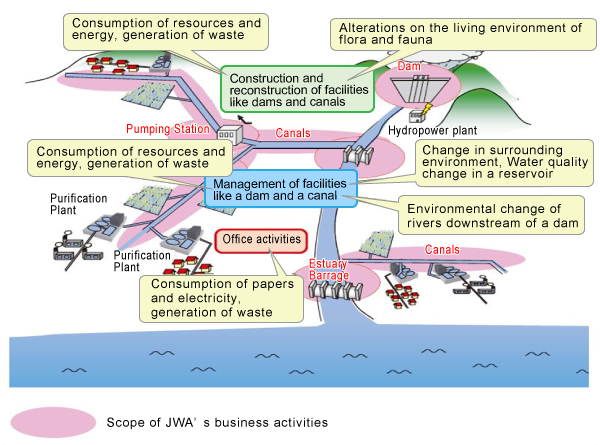
The Japan Water Agency stipulated the following “Environmental Policy” to illustrate its basic concept and principle to foster the environment, as follows:
The Japan Water Agency is carrying out its own Environment management system (called W-EMS*1) in pursuit of high operational efficiency across the organization since FY2018 and is promoting its environmental conservation activities, trying to achieve target management based on PDCA cycle and secure the quality system. Our W-EMS is our own system developed to pursue the operational efficiency and secure its system quality to the highest level, based upon our know-how fostered through our operations to follow ISO14001, an international standard for environment conservation, which we were certified for approval in 2012 for our entire organization.
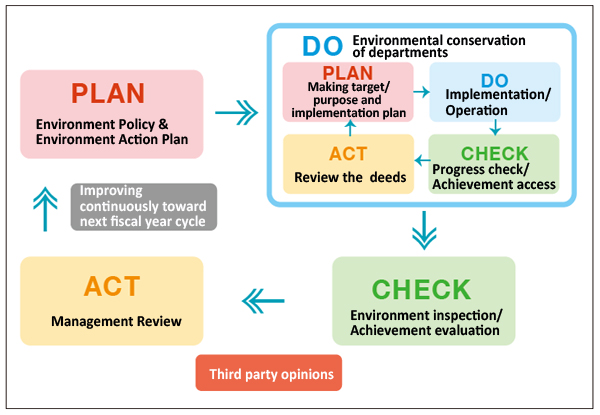
In order to implement environment conservation in a systematic and effective manner, it is essential to tackle it across our organization. Under our management, our Senior Director General for Engineering Affair was appointed the top of the environment management system and respective offices, including the Headquarters and Regional Offices, are appointed as actual driving forces. Respective offices appoint departments being responsible for each target subject and under such departments, environment promotion staff is appointed by the head of the departments to carry out and manage such a target. The head of the department is responsible for checking and confirming the progress status of the target on a quarterly basis and taking necessary steps to achieve such a target. Organization-wide management is carried out in that the top of environment management are responsible for confirming the progress status of the targets on a semi-annual basis and designated environment inspection team is performing inspections. In addition, the management are responsible for confirming the progress status of the target of each department on a yearly basis and perform the management review, in pursuit of enhancement of environment conservation approach.
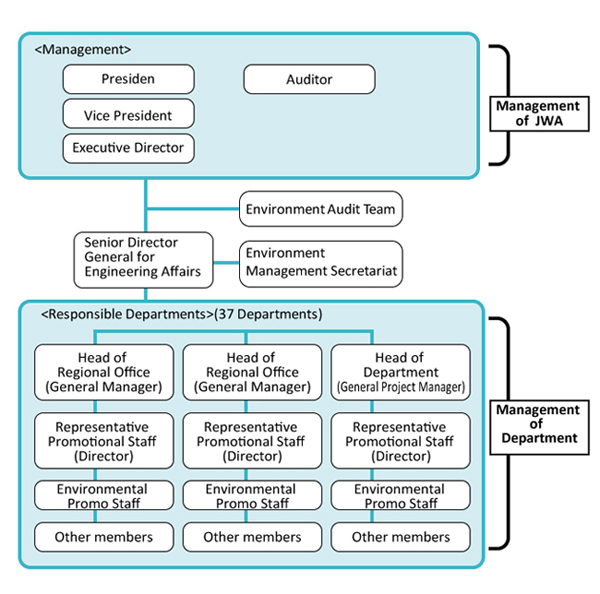
*1 EMS: Environmental Management System
Each responsible department selects the appropriate items to tackle for the year out of the categories of proposed environmental conservation items stipulated and listed in the environmental action plan and individually set up the yearly purpose, target and specific implementation plan. In the case of 2018, JWA set up a total of 543 individual targets and promoted its conservation programs. For some of the departments which failed in accomplishing the set targets in a previous year tries to attain the targets for achievement again in the said year upon the review of failure analysis for corrected trial in the said year. In the case of the year 2018, for those targets which were evaluated as C or D grade, re-trial was made to get A or B score in 2019. Overall, re-trial resulted in success. So, that proved the proper improvements were performed over one year.
Environment Audit, including the inspection of progress status of the target action taken by each responsible department is carried out from November through December. Such audits were implemented in 2019 for 10 departments. Three targets (three departments) were found not sufficient enough and necessary corrective actions were implemented. The audit also includes the pick-up of the excellent actions taken so that those could be adopted in other departments. In 2019 11 cases were reported for recommendations for model examples for other departments. In the case of 2019, on 1 July, the management review was performed for 2018 programs.
In 2018, the following educational trainings were implemented for learning the proper implementation of W-EMS and acquisition of necessary knowledge and information, as follows:
Implementation of environment survey and environmental conservation measures JWA’s business is in many cases performed in the nature-rich mountainous regions. Construction of facilities like dams and canals involves alterations of nature. In this respect, JWA is very much concerned about the conservation of natural environment and is endeavoring its preservation. When newly constructing or reconstructing its facilities, JWA always implements advanced surveys of the work site and its surroundings for the purpose of conservation of environment and conducts impact predictions, then based on them, it carries out environmental conservation measures. For such measures taken, it always verifies the effects with monitoring surveys. In addition, as part of the management operations of dams and canals, JWA gets hold of any changes on natural environment in the surroundings of facilities due to the operations of such facilities and takes necessary actions in consideration of the surrounding environment.
Under the Kawakami Dam construction project, the relocation of giant salamanders has been under way since 2016 as they were designated as special naturally protected species and were living within the estimated filling zone. It was considered one of the challenges we should take to safely relocate them to the comfortable habitat after getting approval by the authority of Cultural Affairs Agency. In April 2018 when we were working on the dam body and were engaged in guiding the change of stream to a temporary discharge tunnel, we found a giant salamander, so relocated it to the upstream. Searching for other possible salamanders in the stream for four days and nights, we drained the stream, removed gravels and floated tree roots, etc., sometimes using heavy machines to remove rocks to find and protect salamanders sneaking out from the hidden areas. In this operation, we checked and confirmed the work completion with the expert for work section by section and on the third day of this operation, we held the conservation measures study meeting and had the operation checked by the professionals to confirm our safe relocation actions.
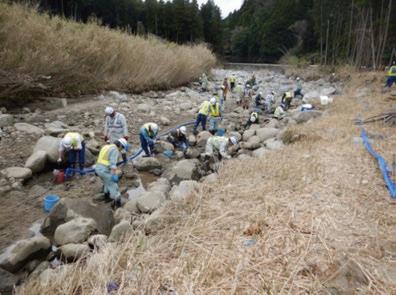
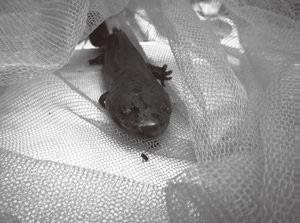
Under Omoigawa Development project, we caught Japanese eight-barbel loaches living in the stream within the expected filling zone and relocated them to the environment conservation zone, following the instructions from the expert in ecosystem and specialized in fish species. This was part of our measures to protect rare species.
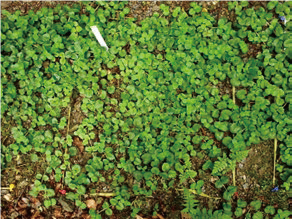
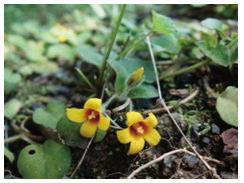
Transplanted lysimachia tashiroi
◢Monitoring of transplanted plants
Under the Koishibarakawa Dam construction project, we have been conducting transplanting of seven species of conservation plants as important conservation plants. For collective 78 pieces of different plants we transplanted in previous years, we conducted surveys to cover the counting of the growing plants, growth conditions, and surrounding environments and evaluated their growth status in a transplanted areas. As a result, we found the death of one out of seven target conservation species due to little rain in 2019 but for remaining six species, their growing conditions were confirmed in good condition.
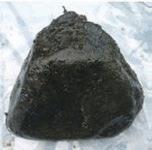
Before removal of adhered moss
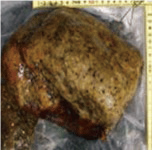
After the removal of adhered moss
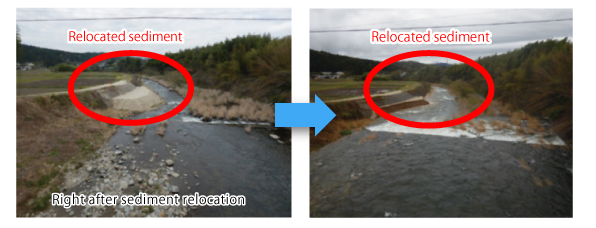
When a dam is constructed, sediment supply to the river downstream of the dam tends to decrease and the river flow also tends to become smooth and level off, all of which can cause a certain degree of impact to the river environment, including the living environment of water creatures and the landscape. To cope with such an impact, we are implementing the measures such as flexible management test of the dam including the flashing discharge to the river downstream from the reservoir*1 and sediment relocation from the reservoir to the river downstream. Such measures can effectively improve the environment*1 and effective use of sediment.*2 At the Agigawa Dam, sediment relocation from the reservoir to the river downstream has been and is conducted since FY2005 and flashing discharge from FY2015. In the case of relocation of sediment, the sediment accumulated at the storage dam in the upstream of the dam is dug up and relocated to the river downstream of the dam, thus effective use of sediment is applied in addition to the environment improvement on the river downstream. In the end, it was confirmed that both measures had contributed to the increase of fine-grained sediment on the river as well as the removal and renewal of adhered moss in the downstream of Agigawa Dam.
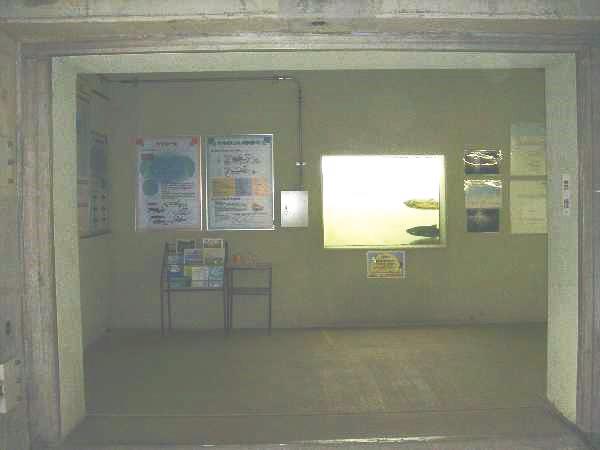
After the removal of adhered moss
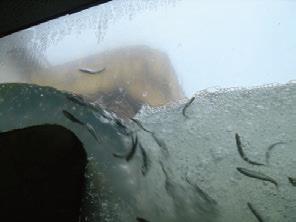
At the facilities of the estuary barrages, we have been conducting surveys of fish run-ups to check and evaluate the effect of fishways and gate operations to guide fishes for run-ups. At the Tone Barrage, we installed three fishways to help fishes run up on the Tone River and during the period of sweet fish’s run-ups, we make a point of conducting gate operation to promote their run-ups. Thanks to this operational help, we fortunately find their smooth run-ups every year though there have been some fluctuations of their counts. We installed the observation window by the fishway on the right bank. During the above period, we keep providing live pictures of the fishway on our website to let the interested people watch them and understand how effectively fish takes the way upward.
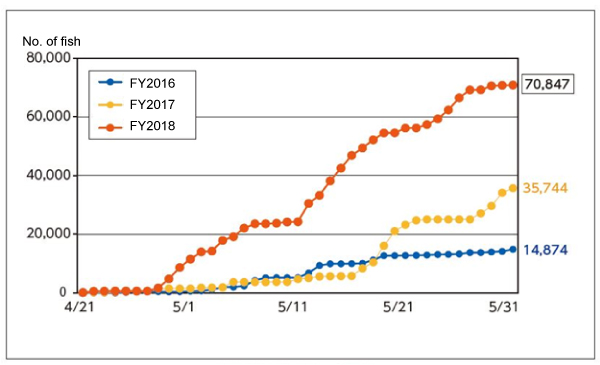
Head count of run-ups of sweet fishes

 Sitemap
Sitemap